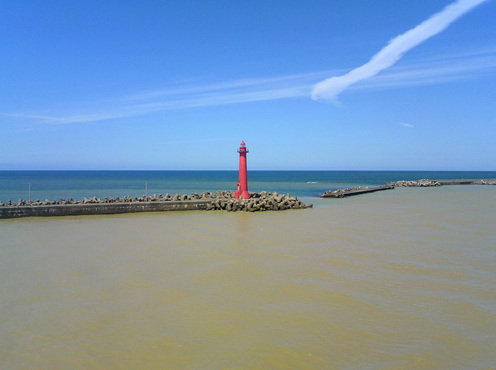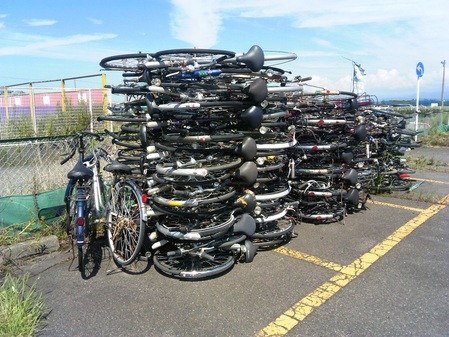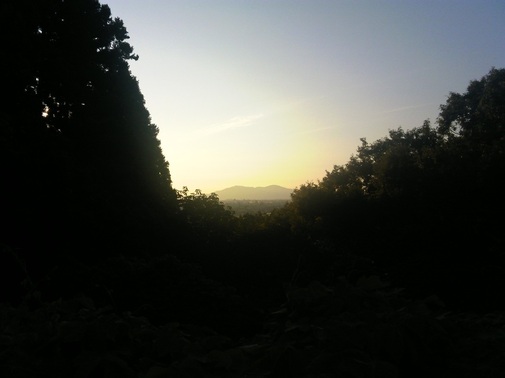The hard-to-understand and hard-to-deal-with caretaker was back from his holidays, and had been collecting rubbish on the beach with some colleagues of his from the local council. They had been up since four in the morning, he said, and I realised as I was packing my gear onto the Rock Spring that in my eagerness to clean up the barbecue area a couple of days earlier, I had thrown away their toothbrushes, having mistaken them for the lost property of a forgetful camper. Not wanting to hang around in case the caretaker cottoned on to my mistake, I was on the road before seven and at the ferry terminal in Ryotsu by eight.
There I got talking to another cyclist from Ibaraki, who had a fancy-looking racing bike and had stayed on Sado for just one night. Resisting the temptation to ask him for a lift back – his car was in Niigata – I went upstairs to buy my ticket and check out the souvenir shops, and on the way found this farm produce vending machine (garlic – 200 yen, onions – 200 yen, potatoes – 200 yen, odourless garlic – 300 yen).

The seagulls had worked out that while there was no point in going to meet an incoming ferry – most of whose passengers will have tired of handing out crisps and snacks by the end of their journey – a whole new set of people will be on hand when the same ferry heads back to the mainland, so by the time we set sail, the MSG feeding frenzy was already in full swing.
This was the view back towards Sado – or the southern half of it, at least.

And this was the view as we pulled into Niigata port, where muddy flood water was still flowing into the clear blue of the Japan Sea.

The temperature hit thirty for the first time on the trip, and as I headed south from Niigata City my forearms felt like doner kebabs, basted in sunblock and almost visibly turning a darker brown in the harsh sunlight. Route 8 was long, straight and flat, and with a tailwind to help me along, I felt refreshed and ready for the journey home. In other words, something was bound to go wrong, and not long after passing this graveyard for broken bicycles – a bad omen if ever there was one – it felt as if I was cycling over corrugated iron rather than smooth tarmac, and a kind of rubbery slapping sound started to come from the back wheel.

It was, of course, a flat tyre, and I’m proud to say that I didn’t panic. After all, it was just last year that I completed a six-week bicycle maintenance evening class at Hammersmith and Fulham Adult Education Centre, and I was carrying all the necessary tools to instigate a speedy repair. Sure, the back wheel is always trickier to deal with than the front, but it was nothing I couldn’t handle, so I found a shady spot in a supermarket car park and went to work.
Panniers off, bicycle upside down, 15mm spanner, unscrew wheel nuts, disentangle back wheel from chain, remove back wheel, unscrew valve nut, prise off tyre, remove inner tube, re-inflate inner tube, listen for escaping air to locate puncture hole, realise that rather than having a single puncture hole, inner tube has worn through…
Oh dear.
I’ve had a few punctures in my time, but I can honestly say that I’ve never had an inner tube disintegrate on me before, and as a consequence, I hadn’t bothered to bring a spare. Looking at the tube, two areas on either side of the valve looked like the knees from a particularly old pair of jeans, and both were bigger than the repair patches I was carrying with me. I did my best bodge job, re-attached everything to the bike and cycled off down the road, but the tyre went soft again almost immediately. A nearby hardware store didn’t have inner tubes in the correct size (700 x 35c, in case you were wondering), so the staff there directed me to a shop called Koidé-jitensha (漕いで自転車 / Pedalling Bicycles).
When I walked in, a man in his eighties was repairing a shopping bike in that leisurely, unhurried fashion that only a professional of several decades’ standing can properly carry off.
‘Excuse me,’ I said, ‘but would you happen to have a 700 x 35c inner tube?’
‘Hang on, I’ll just go and get my son,’ he said, before disappearing through the front door of the house over the road.
The son had soon located a stockpile of 700 x 35cs, and just in case the front one went as well – which was a distinct possibility on such a cheap Chinese bike – I shelled out 1900 yen for two of them (this, I decided, was the emergency for which I had set aside 2500 yen of my remaining budget). The son didn’t seem to mind that I couldn’t afford to have him fit the tube for me, so the two of them looked on as I did the job myself, in that fumbling, inept fashion that only a rank amateur (or an alumni of Hammersmith and Fulham Adult Education Centre) can properly carry off.
If you’re not particularly interested in the whys and wherefores of bicycle maintenance – a description that I assume encompasses pretty much everyone who reads this blog – then feel free to skip this next bit, as it’s a list of the various pieces of technical advice they gave me:
– Don’t screw the the valve nut too tightly against the wheel, as this can damage the tube
– If, on the other hand, the valve isn’t sticking out very far from the wheel, this means the tyre isn’t properly inflated
– Spin the wheel before you re-attach it to the bicycle to check that it’s regular and bulge-free. If there’s a bulge in the tyre, this means the tube has become pinched between the wheel rim and the tyre
– When you put the bicycle the right way up again after completing the repair, re-tighten the wheel nuts
I realised as I cycled off that this could just as easily have happened when I was in the middle of nowhere, and while getting a puncture was bad luck, getting a puncture within five minutes’ walk of a specialist bicycle shop was good luck of the very highest order.

It wasn’t long before I had reached Ohzaki-yama Park in the hills above Sanjoh City. As well as a campsite, the park had its own mini-onsen, although this was about to be over-run by a party of about fifty school children, so I bathed and shaved in about five minutes flat.
‘Can you use a Japanese-style toilet?’ said the receptionist when I arrived back from eating out in Sanjoh.
‘I can, although it’s a bit hard on the knees if you’ve been cycling all day.’
Squat toilets are still quite common in older buildings and public washrooms, and while I can use one in an emergency, my entire lower body tends to seize up in the process.
‘That’s OK,’ he said. ‘The side door is normally locked, but I’ll leave it open tonight in case you want to come in and use the western-style one.’
Now that’s what I call catering to the needs of your customers.
Of course, what I really meant to say was, ‘Now that’s what I call catering to the knees of your customers’ – boom boom!